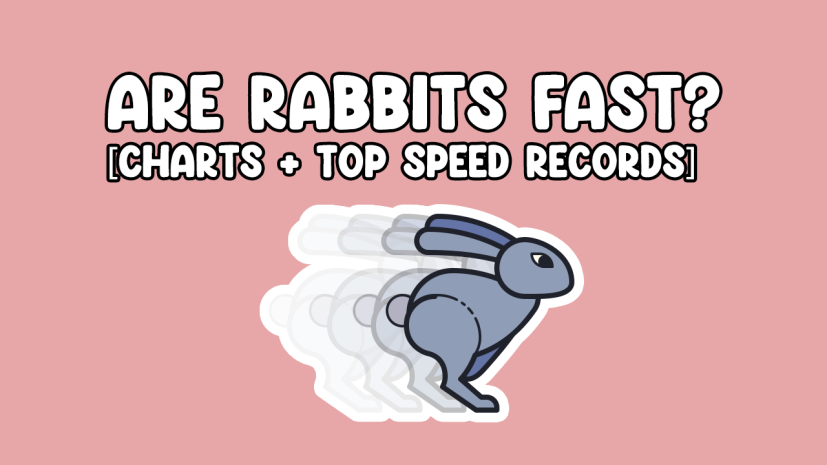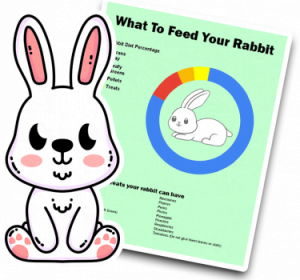
Rabbits, often associated with cuteness and tranquility, have many facets that make them fascinating species to explore.
One aspect that strikes curiosity in many minds is their speed. Are rabbits fast? If you’ve ever watched a rabbit dart away in a flash or seen one on a racecourse, you already have a glimpse of the answer.
This article sheds light on the captivating world of rabbits, their speed, and the factors influencing it. So, buckle up, and let’s embark on this exhilarating journey!
Yes, rabbits are indeed fast! Speed is an integral part of a rabbit’s life, crucial to survival in the wild. Depending on the species and environment, a rabbit can reach speeds ranging from 25 to 45 miles per hour, depending on their age, breed, and size. Unlike other animals, Rabbits expend all their stamina very quickly.
This incredible pace is made possible due to their unique physical attributes like large, muscular hind legs, a lightweight body, and a flexible spine.
Rabbits are designed for speed. Their powerful hind legs act as springs, propelling them forward rapidly when escaping predators. Not only do their large hind legs give them speed, but they also provide the necessary force for the rabbits to perform impressive leaps and bounds, allowing them to cover considerable ground quickly.
Regarding the question “Are rabbits fast?” the answer can be slightly different depending on whether we’re talking about wild or domestic rabbits. Wild rabbits, such as the cottontail rabbit, can reach up to 30 miles per hour. This high speed is essential in the wild, where the ability to outrun predators can mean the difference between life and death.
Domestic rabbits, on the other hand, tend to be slightly slower due to selective breeding and a more relaxed lifestyle. For instance, the popular Dutch rabbit typically runs around 25 miles per hour. Despite the disparity, it’s important to note that these speeds are still impressive, especially considering the small size of the rabbits.

Among domestic breeds, the Belgian Hare tops the list for speed. Don’t be deceived by its name; it’s a rabbit, not a hare. This breed is known for its slender and athletic body structure, which heavily resembles a wild hare, hence the name.
Belgian Hares can reach impressive speeds due to their large, powerful hind legs and lightweight bodies. These attributes are remarkably similar to those of their wild counterparts, aiding in their swift movement.
Belgian Hares typically weigh between 6 to 9 pounds, and their agile, muscular build contributes significantly to their speed. Furthermore, they are active and energetic, enhancing their ability to move quickly.

At the other end of the spectrum, we have the French Lop. Renowned for its size and adorable droopy ears, the French Lop is one of the largest and heaviest rabbit breeds. It typically weighs 10 to 15 pounds, although some can reach up to 20 pounds.
The size and weight of French Lops significantly impact their speed, making them one of the slowest domestic rabbit breeds. Their bulky body structure makes it more challenging for them to move swiftly than their lightweight counterparts.
Despite their slow speed, French Lops are known for their placid and friendly nature. They might not win a race against other breeds but surely win hearts with their lovable personality and charm.
Wild and domestic rabbits are built for short bursts of intense speed. Their muscular hind legs and lightweight bodies allow them to accelerate quickly to evade potential predators or chase down a playmate. Typically, a rabbit can reach speeds of up to 25 to 45 miles per hour, depending on the breed and individual characteristics.
However, sustaining such high speeds requires a significant amount of energy. For this reason, rabbits typically run at their top speed for short periods, ranging from a few seconds to a couple of minutes. This pattern of quick sprints followed by periods of rest allows them to conserve energy while still being able to react quickly to threats.
Think of rabbits as the sprinters of the animal world. Just like human sprinters who can run incredibly fast but only for short distances, rabbits also excel in quick, short-distance runs. Their speed and agility are designed more for evasion and escape than long-distance endurance.
Understanding the exceptional speed of rabbits entails diving into their physical and behavioral adaptations. Their skeletal structure is primarily designed for speed and maneuverability. Rabbits have disproportionately large hind limbs that offer a powerful propulsion force. Their lightweight bodies and flexible backbone enable agility and swift movements, essential for quick direction changes.
Behaviorally, rabbits employ a zig-zag running pattern when they sense danger. This unpredictability of movement and their fast speed make it difficult for predators to catch them. This unique blend of physical traits and instinctive behaviors allows rabbits to be among the swiftest creatures for their size.

In the rabbit world, a ‘binky’ is a term of endearment used to describe a unique behavior exhibited by our furry friends. It is an acrobatic maneuver where a rabbit leaps into the air and twists its body and head in opposite directions before landing. Binkies are typically a sign of happiness and contentment.
But beyond expressing joy, binkies also showcase rabbits’ incredible agility and speed. The rapid change in direction mid-air during a binky is a testament to their nimble body and quick reflexes. It’s almost as if they’re rehearsing their evasive maneuvers to escape predators.
When a rabbit performs a binky, they’re demonstrating their happiness and ability to change direction quickly. This agility aids them significantly when they need to make sharp turns at high speed, an essential survival tactic in the wild.
The rabbit’s tail, commonly known as a ‘scut’, plays an interesting role in their navigation, especially when making sharp turns.
When a rabbit runs at full speed, their tail lifts to expose the bright white underside. This sudden flash of white often acts as a visual alarm for other rabbits in the vicinity, signaling potential danger.
Speed is a common survival mechanism in the animal kingdom, and comparing rabbit speed to other animals provides an interesting perspective. Dogs, for instance, depending on the breed, can reach speeds of 20 to 45 miles per hour. On the other hand, domestic cats can clock around 30 miles per hour. Humans, even the fastest among us, can only achieve a top speed of about 28 miles per hour.
When compared, it’s clear that despite their size, rabbits stand their ground. They may not be the fastest in the entire animal kingdom, where cheetahs reign supreme, but their speed is nothing short of impressive when considering their size and environment.
This is a rough chart based on 10 seconds of travel, It’s challenging to accurately measure the acceleration of a non-mechanical entity like an animal. Unlike vehicles, animals don’t maintain a steady acceleration, and their movement can be influenced by various factors such as terrain, motivation, fear, and individual health.
| Animal | Top Speed (mph) |
|---|---|
| Peregrine Falcon (in a dive) | 240 |
| Golden Eagle (in a dive) | 200 |
| Cheetah | 58-61 |
| Pronghorn Antelope | 55 |
| Springbok | 55 |
| Wildebeest | 50 |
| Lion | 50 |
| Thomson’s Gazelle | 50 |
| Jackrabbit (Hare) | 45 |
| Greyhound Dog | 43 |
| Domestic Cat | 30 |
| Fox | 31 |
| Cottontail Rabbit | 18 |
| Squirrel | 12 |
| Mouse | 8 |
Yes, a rabbit is generally fast. Rabbits are known for their speed and agility, often reaching speeds of up to 25 to 45 miles per hour depending on the breed and individual characteristics. Their swift movement is primarily an evasion tactic against predators.
While rabbits are quick, most domestic cats are faster. On average, a domestic cat can reach speeds of up to 30 miles per hour. However, certain breeds of rabbits, such as the Belgian Hare, can come close to this speed.
This largely depends on the breed of the dog. Some dog breeds, like Greyhounds and Salukis, can reach speeds up to 45 miles per hour, which is faster than most rabbits. However, rabbits could potentially outrun slower dog breeds.
The speed of a domestic rabbit can vary based on breed, age, and health. However, most domestic rabbits can reach speeds of 25 to 30 miles per hour in short bursts. Belgian Hares, one of the fastest domestic breeds, can reach speeds nearing that of a wild rabbit.

By entering your email address you agree to receive emails from Cottontailclub. We'll respect your privacy and you can unsubscribe at any time.